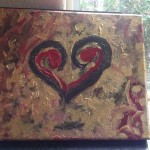During the recent holidays, I was sick for some time. I didn’t have energy to exercise or even go for a simple walk. So I thought why not try to do something that would make me feel good about myself, and wasn’t physically demanding; I decided to paint.
First Things First

The Art

Everyone is a Critic
The Power of the Creative Arts in Health and Healing The benefits of creativity are plentiful.

Engaging in any creative process is healing.
Each day in the Healing Arts Program at Montefiore Health System, we see how engaging with the creative arts can be a powerful healing experience for people facing illness and other health challenges.
What does creativity have to do with health, healing and well-being? Studies show that engaging in any creative process is healing. Whether you make a simple drawing or collage, look at art or talk about it, creativity and the arts can help you:
- Express thoughts and emotions that can be hard to put into words
- Lower stress and anxiety
- Relax and feel calmer and happier
- Connect with yourself on a deep level, no matter what you are going through
- Find meaning in life experiences
- Cope with grief and loss
- Form new connections with others
- Shift your focus away from pain or stressful thoughts to activities that are soothing, enjoyable and fun
- Create something unique that gives you a sense of pleasure and accomplishment
The traditional healing arts include art, music, dance/movement, poetry/writing and drama therapies. These approaches combine artistic expression with psychological awareness, and are led by a licensed or board-certified creative arts therapist.
The Healing Arts Program’s art therapist works with adult oncology patients, offering them a variety of creative activities while they’re receiving chemotherapy treatment. Projects include making crafts, drawing, painting and collage, and can involve family members. The art therapist also works with patients at the bedside, using creative engagement as part of a therapeutic approach to help them relax, lower anxiety and pain and share feelings and thoughts. This excerpt provides an example of a patient’s experience with a session and how it helped her:
“S. is feeling very unhappy today and talks to me about how frustrated she is with her health situation. I just listen. After a while, I bring out my art supplies and invite her to try out a painting project. She is interested. She makes two paintings. Then she wants more!
“Her nurse comes in and seems happy to see her so engaged. Her conversation now shifts to what is important to her and what keeps her going. She wants to make a painting on canvas using a special technique I show her. She paints all over the canvas just having fun, and then moves to paper and rubber stamps. She is talking positively now. She continues to work on art projects for another two hours, then we look at her painting together. She loves it. She thanks me profusely and comments on how her mood has totally shifted and how much better she feels.”
Simple Ways to Bring the Creative Arts Into Your Life
Many people don’t identify as creative and believe they won’t be able to make art. The special surprise is that everyone is creative. No artistic talent is needed to participate in art therapy or to do creative activities on your own. In fact, for many activities, it’s preferable that you not know “how to do it” and do it the way that feels and looks best to you.
Many hospitals and care facilities offer art therapy. You also may wish to seek out a licensed or board-certified art therapist in your community to help you explore and process what you’re experiencing.
In addition to art therapy, there are many forms of creative expression you can bring into your life to gain enrichment, relaxation, self-awareness and pleasure. Here are some ideas of simple activities. Try the ones that sound most appealing to you.
Relax and unwind.
- Doodle freely with a pencil, pen, marker or crayon. Let your hand flow freely on the page, and see what patterns or lines emerge.
- Color in a picture or mandala using coloring pages for adults.
- Do a repetitive activity such as knitting, kneading Play-Doh or clay or stringing beads on yarn or elastic (knot one end before stringing).
Reflect freely.
- Draw or write whatever is on your mind. Let the images and words come from your hand onto the page without worrying what they look like. When you’re ready to stop, look at the page and reflect on what you see. What does it remind you of or mean to you?
- Create a collage by cutting or tearing pictures, shapes or words from a magazine or newspaper. Choose how you want to arrange the smaller pieces, and glue or tape them onto a piece of paper. You may want to focus on a theme that is meaningful to you or just have fun with the shapes and colors.
- Create a memory box or album by gathering items such as photographs, postcards, ticket stubs, poems and other mementos. You may wish to decorate the box or album too.
Learn a new skill – or decorate something old.
Is there a creative skill you’ve always wanted to learn? This could be painting with watercolors, shaping sculptures, building furniture, quilting or making mosaics. Is there a class near you? There are also many tutorials online that you can follow.
What do you have around you every day? Adding decorations to common objects is fun to do and to look at. Try glitter, fake flowers, pictures cut from magazines and stickers.
Create a healing visual environment.
- Choose an art image you love, and place or hang it where you can see it. What do you love about it? Share your impressions with someone, or write them in a notebook.
- Color has a strong influence on how we feel. Adding cool tones and soft pastels such as blue, green, lavender and pink to your visual environment encourages relaxation. Warm, bright tones such as orange, yellow and red are energizing.
Whichever way you choose to engage creatively, just remember that the creative process itself promotes health and healing, and the most important thing is to experiment and enjoy.
